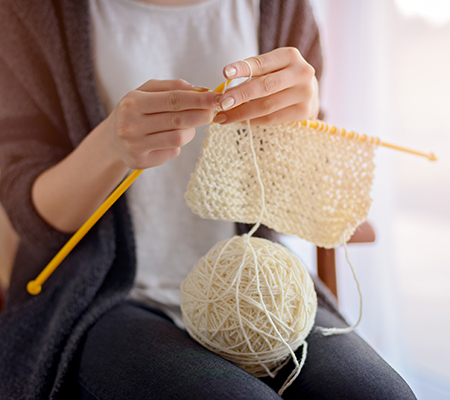
“It helps me decompress from my professional traveling and demands. Knitting is my relaxation.”
For Lea Buckridge, a registered nurse at Marshfield Clinic, this statement describes how she uses knitting to benefit her health. Buckridge has a nursing background in family practice and pediatrics and has been an avid knitter for eight years.
Buckridge’s experience with knitting has been confirmed in studies and surveys of knitters, said Cammie Larson, a Marshfield Clinic occupational therapist.
“Many knitters report the activity helps to cope with stress or find relaxation,” Larson said.
Here, Buckridge and Larson share health benefits of knitting and encourage others to give it a try.
1. Mental health
StitchLinks, a group organized in 2005 to study benefits of knitting and educate others, encourages all age groups to think of knitting as a “bilateral, rhythmic, psychosocial intervention that has the power to transform people’s lives.”
Buckridge speaks of knitting as a sort of medication and stress relief.
History of knitting speaks to this, too. In her reading, Larson learned many women found emotional comfort knitting clothing items for their soldiers in France during WWII.
2. Therapeutic settings
In group therapy, experts suggest knitting can facilitate conversation and improve self-esteem.
“Creating a finished product with your own hands is something to be proud of,” Larson said.
In fact, many cancer patients find similar relief and benefits in art therapy.
3. Fine motor skills
Some have expressed knitting as having helped their dexterity though they have arthritis, as explained by one woman in a New York Times article.
When a patient recovering from a physical injury already knows how to knit, I encourage them to resume the activity on an ‘as tolerated’ basis,” Larson said. “Knitting promotes active finger and wrist movement, dexterity and fine motor coordination that can facilitate improvements in other functional skills.”
If they don’t know how to knit, Larson might encourage learning to knit, or trying similar activities like scrapbooking or crocheting.
Additionally, there are schools across the country that incorporate knitting into curriculum. The activity is said to develop fine motor skills among other abilities like learning to read, as knitting exercises both sides of the brain.
4. Cognitive anchoring
Some people learn best while doing another activity. This may come across as doodling or fidgeting.
Lo and behold, knitting is a perfect activity for this type of learning, cognitive anchoring.
Learning a new language? Studying for an exam? If you learn best by cognitive anchoring, try knitting.
5. Memory
“Studies show craft skills like knitting can help reduce memory concerns or prevent memory loss,” Buckridge said.
An article in the Journal of Neuropsychiatry and Clinic Neurosciences studied mild cognitive impairment (MCI) associated with aging. They found, “Computer activities; craft activities, such as knitting, quilting, etc.; playing games; and reading books were associated with decreased odds of having MCI.”
How to get started
Find a local yarn store and ask if they have beginner classes, or join a knitting club at a college.
“You also can learn to knit from YouTube videos or online tutorials, but I think it’s more helpful to have an expert teaching you in person,” Buckridge said.
Consider a “learn to knit” kit to get started.






Leave a Reply